Incheon International Airport
Incheon International Airport (Korean: 인천국제공항; IATA: ICN, ICAO: RKSI; sometimes Seoul–Incheon International Airport) is the largest airport in South Korea. It is the primary airport serving the Seoul Capital Area and one of the largest and busiest airports in the world.
Incheon International Airport 인천국제공항 | |||||||||||||||||||||||
|---|---|---|---|---|---|---|---|---|---|---|---|---|---|---|---|---|---|---|---|---|---|---|---|
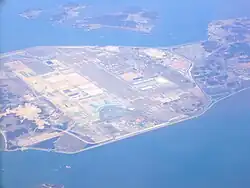 Incheon Airport from the air | |||||||||||||||||||||||
| Summary | |||||||||||||||||||||||
| Airport type | Public | ||||||||||||||||||||||
| Owner | Ministry of Land, Infrastructure and Transport | ||||||||||||||||||||||
| Operator | Incheon International Airport Corporation | ||||||||||||||||||||||
| Serves | Seoul Capital Area | ||||||||||||||||||||||
| Location | Jung District, Incheon, South Korea | ||||||||||||||||||||||
| Opened | 29 March 2001[1] | ||||||||||||||||||||||
| Hub for | |||||||||||||||||||||||
| Elevation AMSL | 7 m / 23 ft | ||||||||||||||||||||||
| Coordinates | 37°27′48″N 126°26′24″E | ||||||||||||||||||||||
| Website | www.airport.kr | ||||||||||||||||||||||
| Maps | |||||||||||||||||||||||
Closeup of airport on map | |||||||||||||||||||||||
| Runways | |||||||||||||||||||||||
| |||||||||||||||||||||||
| Helipads | |||||||||||||||||||||||
| |||||||||||||||||||||||
| Statistics (2019) | |||||||||||||||||||||||
| |||||||||||||||||||||||
| Incheon International Airport | |
| Hangul | |
|---|---|
| Hanja | |
| Revised Romanization | Incheon gukje gonghang |
| McCune–Reischauer | Inch'ŏn kukche konghang |
As of 2021, the airport has been rated by Skytrax as the fourth-best airport in the world. Skytrax also has rated the airport as the world's best international transit airport and one of the world's cleanest airports. The airport is one of Skytrax's 5-star airports and also has been awarded for the best airport security in 2021.[4][5][6][7]
During the entire run of the best airport worldwide ranking by Airports Council International (ACI) from 2005 to 2011, Incheon International Airport topped the ranking every year. ACI also rated the airport as the best airport in Asia-Pacific for 10 consecutive years from 2006 to 2016 until the ranking series ended in 2017.[8] The airport has been ranked first place in the services field regardless COVID-19 term. Incheon International Airport Corporation declared ‘COVID-19 Free Airport.’ It took the lead in quarantine against the spread of coronavirus. Also, the airport tried to prevent the collapse of the aviation industry during COVID-19. At the same time, despite the huge deficit, a policy of rent reduction and mooring usage fee exemption was implemented to ensure employment stability for 70,000 airport workers.[9]
The airport has a golf course, spa,[10] private sleeping rooms, an ice skating rink, a casino, indoor gardens, video game center and the Museum of Korean Culture. The airport's average departure and arrival take 19 minutes and 12 minutes respectively, as compared to a worldwide average of 60 minutes and 45 minutes, ranking it among the fastest airports in the world for customs processing.[11] Its duty-free shopping mall has been rated the world's best for three years in a row in 2013 by Business Traveller.[12] Incheon International Airport also reports a 0.0001% baggage mishandling rate.[13]
The airport opened for business on 29 March 2001 to replace the older Gimpo International Airport, which now serves mostly domestic destinations and shuttle flights to several East Asian metropolitan areas, including Beijing Capital, Osaka Kansai, Shanghai Hongqiao, Taipei Songshan and Tokyo Haneda.
Incheon International Airport is located west of Incheon's city center, on an artificially created piece of land between Yeongjong and Yongyu Islands. The two islands were originally separated by a shallow sea. That area between the two islands was reclaimed for the construction project, effectively connecting the once-separate Yeongjong and Yongyu islands. The reclaimed area as well as the two islands are all part of Jung-gu, an administrative district of Incheon. The airport has 111 boarding gates altogether, with 44 in Terminal 1, 30 in Concourse A (connected to Terminal 1), and 37 in Terminal 2.
The airport was constructed to share the demand for air transport in the 21st century and to serve as a hub airport in Northeast Asia.[14]
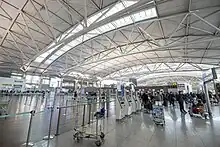
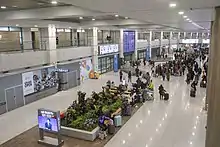
History
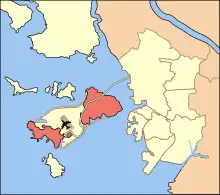
International air traffic to South Korea increased after the 1988 Summer Olympics. In the 1990s, it became apparent that Gimpo International Airport could not cope with the increase in air traffic. To reduce the load on Gimpo International Airport, the government decided to build a new international airport.
The new airport was originally planned to be located in Cheongju, 124 km (77 mi) southeast of Seoul, but due to its distance, it was opposed by Seoul and Gyeonggi citizens. Hwaseong was the other choice, but it was also rejected due to similar reasons. Finally, the area chosen was Incheon.
In November 1992, the construction of the Incheon airport began on reclaimed land between Yeongjong Island and Youngyu Island and took eight years to finish, with an additional six months for testing. Completion was initially scheduled for 1997 but delayed due to the economic crisis.[15] The airport was officially opened on 21 March 2001.
On 15 November 2006, the Airbus A380 landed at the airport as part of the first leg of its certification trip.[16] Tests on the runways, taxiways, and ramps showed that the airport could handle the aircraft.
To further upgrade service, Incheon and major Korean logistics firm Hanjin Group (parent company of Korean Air) agreed on 10 January 2008 to build Yeongjong Medical Centre, which was completed in 2012. This hospital serves nearby residents and some of the 30,000 medical tourists who come to Korea annually.[17]
Statistics
Located 48 km (30 mi) west of Seoul, the capital and the largest city of South Korea, Incheon International Airport is the main hub for Korean Air, Asiana Airlines, Jeju Air, and Polar Air Cargo. The airport serves as a hub for international civilian air transportation and cargo traffic in East Asia. In 2016, the Incheon International Airport was the fifth-busiest airport in the world and third in Asia by cargo traffic, and 19th in the world and eighth in Asia by passenger traffic. In 2016, the airport served a total of 57,849,814 passengers.
The airport opened for business in early 2001 to replace the older Gimpo International Airport, which now serves mostly domestic destinations plus shuttle flights to Beijing (Capital), Osaka (Kansai), Shanghai (Hongqiao), Taipei (Songshan) and Tokyo (Haneda) although flights to Beijing and Osaka also operate from Incheon Airport.
Construction phases
The airport was originally planned to be built in three phases, incrementally increasing airport capacity as the demand grew. This was changed, however, to four phases after the airport was opened.
Phase 1
In Phase 1, the airport had a capacity of 30 million passengers annually, and a cargo capacity of 1,700,000 tonnes (1,673,151 long tons; 1,873,929 short tons) annually. In this phase, a passenger terminal with a floor space of 496,000 square metres (5,338,900 sq ft), two parallel runways, a control tower, an administrative building, a transportation Centre (the Integrated Transportation Centre, designed by Terry Farrell and Partners and Samoo Architects & Engineers), an integrated operations Centre, three cargo terminals, international business Centre, and a government office building were constructed.
Phase 2
Phase 2 construction began in 2002, and was originally expected to be completed in December 2008. However, in an attempt to have the airport ready for the 2008 Beijing Olympics, which took place in August 2008, the schedule was modified, and Phase 2 construction was completed on 20 June 2008. During this construction phase, a third parallel 4,000-metre-long (13,123 ft 4 in) runway and a 13-hectare (32.1-acre) cargo terminal area was added. A 16.5-hectare (40.8-acre) concourse connected to the main passenger building via two parallel 870-metre-long (2,854 ft 4 in) underground passageways were added, with a Mitsubishi Crystal Mover shuttle train APM shuttling passengers between the concourse and the main terminal.[18]
Many long-distance foreign carriers were moved to the new concourse, with Korean Air and Asiana Airlines continuing to use the existing terminal.
Phase 3
The South Korean government invested ₩4 trillion until 2017 to expand Incheon International Airport. The second passenger terminal was constructed in the northern field of the airport, and its existing cargo terminal and other infrastructures were expanded. The terminals are connected to each other by the underground "Starline" train. Also, a Landside Connecting system (Bus shuttle) is used for airport employees and departing passengers who don't come to the right terminal. After completion, Incheon International Airport is able to handle 62 million passengers and 5,800,000 tonnes (5,708,398 long tons; 6,393,406 short tons) of cargo a year, up from the previous capacity of 44 million passengers and 4,500,000 tonnes (4,428,929 long tons; 4,960,401 short tons). Construction began in 2011 and was completed in 2017. The terminal opened on 18 January 2018. Incheon's expansion also includes adding more aprons to park planes and extending a railway line to the city center of Seoul about 70 kilometres (43 mi) away from the airport. The airport also signed an agreement to build a resort called "Inspire" which includes 6-star hotels, theme parks, and a casino.[19]
Phase 4
Between 2017 and 2024, a fourth construction phase at the airport is taking place. There will be an expansion of Terminal 2, the building of a fourth runway and additional apron and car parking facilities.[20] Following completion of the works, it is expected that the hourly flight capacity of the airport will increase from 90 to 107.[21]
There are long-term plans for a fifth runway and a third terminal.[22]
Terminals
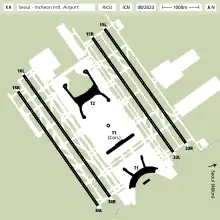
Terminal 1
Terminal 1 (measuring 496,000 square metres (5,338,900 sq ft)) is the largest airport terminal in the area in South Korea. Terminal 1 was designed by Curtis W. Fentress, FAIA, RIBA of Fentress Architects. It is 1,060 metres (3,480 ft) long, 149 metres (489 ft) wide, and 33 metres (108 ft) high. Its construction cost was 5.632 trillion South Korean Won.[23] The terminal has 44 boarding ports (all of which can accommodate the Airbus A380), 50 customs inspection ports, 2 biological quarantine counters, 6 stationary and 14 portable passenger quarantine counters, 120 arrival passport inspection counters, 8 arrival security ports, 28 departure security ports, 252 check-in counters, and 120 departure passport inspection counters. In 2015, an automatic check-in counter lane was introduced, which people travelling via Korean Air, Asiana Airlines and China Southern Airlines can use. Instead of having airport staff at the counter, there is a machine where travellers input their flight information, scan their passports, receive their flight tickets and lastly, load the luggage onto the conveyor. This system was planned to be introduced in Terminal 2, but in May 2015 Incheon Airport used one of the counter islands for the unmanned luggage handling system.[24]
Midfield Concourse

The passenger concourse was completed at the end of May 2008. It is connected to Terminal 1 by two parallel 870-metre-long (2,850 ft) underground passageways equipped with IATs (Intra Airport Transit). It has 30 gates and six lounges[25] (Asiana Airlines/Star Alliance, Singapore Airlines/Star Alliance, Japan Airlines/Oneworld, Korean Air/SkyTeam, and China Eastern Airlines/SkyTeam).
Terminal 2
A new passenger terminal, designed by Gensler, opened on 18 January 2018, and Korean Air, KLM, Delta Air Lines, and Air France flights were relocated from Terminal 1 to Terminal 2. Other SkyTeam members such as Aeromexico, China Airlines, Garuda Indonesia, XiamenAir, Czech Airlines and Aeroflot started serving the Terminal 2 on 28 October 2018. From 1 July 2023, Jin Air, the subsidiary of Korean Air will operate at Terminal 2.[26] And the rest of the SkyTeam members, such as Vietnam Airlines, China Eastern Airlines, Shanghai Airlines and Saudia, will be relocated to Terminal 2 after the Phase 4 construction work is completed.[27]
Airlines and destinations
Passenger
Cargo
Accolades
Incheon International Airport has been the recipient of a number of awards since its opening, including:[157]
- Best Airport Worldwide at the first Airport Service Quality Awards in 2007.[158]
- Won the GT Tested Award for Best Airport in the World in January 2007.[159]
- Named by Global Traveler (GT) as the Best Airport in the World for the second straight year in January 2008.[17]
- Named World's Best Airport for 2009, in the World Airport Survey results published by Skytrax.[160]
- In 2012 it was ranked the best airport in the world by Skytrax.[161]
- In 2018, Incheon International Airport won the Asian Big Airport of the Year award.[162]
- Awards the Best Innovation in Airport Passenger Related Processes from ACI in 2023.[163]
| Year | Award | Category | Results | Ref |
|---|---|---|---|---|
| 2009 | Airport Service Quality Awards by Airports Council International | Best Airport Worldwide | Won | [164] |
| Best Airport in Asia-Pacific | Won | |||
| Best Airport by Size (25–40 million passengers) | Won | |||
| 2010 | Best Airport Worldwide | Won | [165] | |
| 2011 | Won | [166] | ||
| 2021 | 2021 Air Transport World Awards by Air Transport World | Airport of the Year | Won | [157] |
| 2021 World Airport Awards by Skytrax | COVID-19 Airport Excellence | Won | [157] | |
| World's Best Airport Security | Won | [157] | ||
| 2023 | 2023 World Airport Awards by Skytrax | World's Best Airport Staff Service | Won | [157] |
| Best Airport Staff in Asia | Won | [157] | ||
| World's Best Airport Immigration Service | Won | [157] | ||
Accidents and incidents
On 16 June 2011, Airbus A321-200 Flight 324 operated by Asiana Airlines HL7763 between Chengdu Shuangliu International Airport, China and Incheon International Airport was fired upon by two soldiers of the Republic of Korea Marine Corps as it came in to land at Incheon. A total of 99 rounds were discharged at the aircraft, which was out of range and made a safe landing without sustaining any damage. The soldiers had misidentified the aircraft as belonging to the North Korean military and were acting on orders that gave them permission to engage without reference to senior officers, following the Bombardment of Yeonpyeong in November 2010.[167]
Ground transport

Bus
Airport shuttle buses transport passengers between Terminal 1 and Terminal 2. Buses are free, arrive every 5 to 8 minutes, take approximately 20 minutes of travel time, and stop at the Hyatt Hotel or airport fire station en route, depending on direction.
Airport buses are called limousine buses. Standard limousine buses travel to Gimpo Airport & Songjeong station.
Intercity buses connect with other towns and cities in Korea.
The Korea City Air Terminal in Gangnam is linked with the airport through limousine buses.[168]
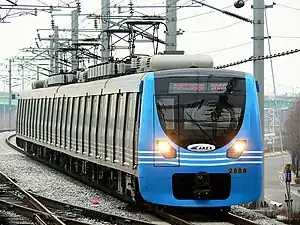
Rail
The Airport Railroad Express (AREX and styled as A'REX) has a station located in the Transport Centre adjacent to the Terminal 1 building and is in the basement of Terminal 2. It provides service to Gimpo International Airport and Seoul. Many of the stations along the line provide connections to Incheon Subway, Seoul Metropolitan Subway, and Incheon Airport Maglev.
For departing passengers, Seoul Station City Airport Terminal has check-in and immigration facilities before arriving at the airport.
The Korea Train eXpress (KTX) operated at the same station as AREX but used a different platform. It operated 20 times per day from the airport; twelve times on the Gyeonbu Line, twice on the Gyeonjeon Line, four times on the Honam Line, and twice on the Jeolla Line. The service started in 2014 but was suspended in March 2018 due to low ridership.[169] The suspension became permanent in September 2018 as the line was officially closed.[170][171]
The Incheon Airport Maglev opened in February 2016. The first phase is 6.1 km long, spread over six stations, taking riders from the airport toward the southwest of the island where a water park is located. Phase 2 will be 9.7 km long, extending the line to the northwest of the island. Phase 3 will add 37.4 km, transforming the line into a circle.[172][173][174]

Ferry
A ferry service connects Yeongjong-do to the mainland. However, the dock is located a considerable distance from the airport. An alternative means of transport must be sought upon arriving at the island to be able to get to the airport.[175]
Car
The airport provides a short-term parking lot for 4,000 cars and a long-term parking lot for 6,000 cars. Shuttle services connect the long-term parking lot to the passenger terminal and the cargo terminal. Car rental is located near the long-term parking lot. A link to the mainland is provided by the toll Yeongjong Bridge and an expressway. A second expressway on the Incheon Bridge also connects the island to central Incheon. The 3rd Landing Bridge that links Yeongjongdo to Cheongna International City is being built now. (Opens in 2025)
Traffic and statistics
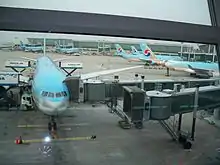
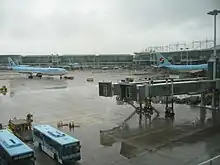
In 2017, the airport was the world's fourth busiest airport by cargo traffic and third in Asia,[176] and the world's 19th busiest airport by passenger traffic and ninth in Asia.[177] In 2019, the airport served a total of 70,857,908 passengers.
Top destinations
Annual traffic
| Years | Aircraft
Operations |
Passengers | Cargo (tonnes) | |
|---|---|---|---|---|
| 2001 | 86,807 | 14,542,290 | 1,186,015 | |
| 2002 | 126,094 | 20,924,171 | 1,705,928 | |
| 2003 | 130,185 | 19,789,874 | 1,843,055 | |
| 2004 | 149,776 | 24,084,072 | 2,133,444 | |
| 2005 | 160,843 | 26,051,466 | 2,150,139 | |
| 2006 | 182,007 | 28,191,116 | 2,336,571 | |
| 2007 | 211,404 | 31,227,897 | 2,555,580 | |
| 2008 | 211,102 | 29,973,522 | 2,423,717 | |
| 2009 | 198,918 | 28,549,770 | 2,313,002 | |
| 2010 | 214,835 | 33,478,925 | 2,684,499 | |
| 2011 | 229,580 | 35,062,366 | 2,539,222 | |
| 2012 | 254,037 | 38,970,864 | 2,456,724 | |
| 2013 | 271,224 | 41,482,828 | 2,464,385 | |
| 2014 | 290,043 | 45,512,099 | 2,557,681 | |
| 2015 | 305,446 | 49,281,220 | 2,595,677 | |
| 2016 | 339,673 | 57,765,397 | 2,714,341 | |
| 2017 | 360,295 | 62,082,032 | 2,921,691 | |
| 2018 | 387,497 | 68,259,763 | 2,952,123 | |
| 2019 | 404,104 | 71,169,722 | 2,764,369 | |
| 2020 | 149,982 | 12,094,851 | 2,822,370 | |
| 2021 | 131,027 | 3,198,909 | 3,329,292 | |
| 2022 | 171,253 | 17,869,759 | 2,945,855 | |
| Source: IIAC Airport Statistics[3] | ||||
See also
References
- "인천국제공항, 개항 21주년 기념식 개최". Retrieved 19 March 2023.
- "해당 월 통계자료는 익월 업무일 기준 5일 이후 공표". Archived from the original on 20 January 2019. Retrieved 20 January 2019.
- "Airport Statistics". Archived from the original on 6 March 2019. Retrieved 15 February 2017.
- "The World's Best Airports for Transit Passengers". Archived from the original on 2 May 2016. Retrieved 7 May 2016.
- "World's Best Transit Airports 2020". Skytrax. Archived from the original on 22 September 2020. Retrieved 15 May 2020.
- "The World's Best Airports in 2021". Skytrax. Retrieved 16 December 2021.
- "5-Star Airports". Skytrax. Retrieved 16 December 2021.
- The Korea Herald (27 May 2014). "Incheon Airport tops service quality for 9th year". Archived from the original on 2 April 2019. Retrieved 10 May 2015.
- 조선일보 (8 November 2021). "세계 공항서비스평가서 12년 연속 1위". 조선일보 (in Korean). Retrieved 10 October 2023.
- "A Guide to Spa on Air – Incheon Airport's Secret Treasure". Escape From Custody. 28 August 2019. Retrieved 26 October 2019.
- "Incheon International named Best Airport Worldwide 7 years in a row". Rus Tourism News. 21 February 2012. Retrieved 4 July 2013.
- "인천공항 면세점, 3년연속 '세계 최고 면세점 선정' – Chosunbiz – 프리미엄 경제 파워". Biz.chosun.com. 1 January 2013. Retrieved 4 July 2013.
- "25 Reasons Incheon International Airport is the Best Airport in the World". Seulistic. 12 July 2012. Retrieved 29 April 2013.
- "인천국제공항" (in Korean). Retrieved 28 March 2018.
- "Incheon". Archived from the original on 22 September 2020. Retrieved 22 May 2019.
- "The long journey to delivery". Archived from the original on 22 September 2020. Retrieved 22 May 2019.
- http://medical.incheon.go.kr/open_content/medical.do?act=medicaldetail&lang=en&medicalno=52&medicaldiv=01
- "Incheon Airport to Open New Concourse". Koreatimes.co.kr. 29 May 2008. Archived from the original on 20 August 2012. Retrieved 28 November 2010.
- "Incheon Airport to Have New Terminal by 2017". Korea Herald. 29 June 2009. Archived from the original on 27 December 2011. Retrieved 29 June 2009.
- "Phase 4 construction overview". Incheon International Airport Corporation. Retrieved 13 March 2021.
- Kim, Hyun-bin (19 November 2019). "Incheon airport initiates 4th phase expansion construction, injects $4.2 bill". The Korea Times. Retrieved 13 March 2021.
- Shim, Woo-hyun (10 May 2020). "No plan yet for fifth runway at Incheon Airport: ministry". The Korea Herald. Retrieved 13 March 2021.
- "Incheon International Airport". www.airport.kr. Retrieved 30 July 2023.
- "Incheon Airport launches new self-service bag drop system". Future Travel Experience. 21 May 2015. Archived from the original on 22 September 2020. Retrieved 7 May 2016.
- "Lounge". Archived from the original on 6 November 2019. Retrieved 22 May 2019.
- "Guide to Incheon Int'l Airport(ICN) Terminal Relocation (Starting from July 1st.)". Jin Air (Press release). Retrieved 11 May 2023.
- 구정모 (22 July 2015). "인천공항, 2018년 제2여객터미널에 대한항공 배치". 연합뉴스. Archived from the original on 22 September 2020. Retrieved 7 May 2016.
- Mpoke Bigg, Matthew; Chokshi, Niraj (5 March 2022). "Aeroflot says it will suspend international flights". The New York Times. Retrieved 6 March 2022.
- "AEROMEXICO NS24 SEOUL OPERATIONS – 18AUG23". Aeroroutes.com. 18 August 2023. Retrieved 18 August 2023.
- "Aero Mongolia to commence Ulaanbaatar-Seoul service in Jun-2023". CAPA Centre For Aviation. Retrieved 20 June 2023.
- Liu, Jim (27 May 2022). "Air Busan Updates Seoul International Network Additions From Late-May 2022". Aeroroutes.
- "Air Busan Plans Bangkok Launch in Late-July 2022". AeroRoutes. 11 July 2022.
- "Air Busan Updates Seoul International Network Additions from late-May 2022".
- "Air Busan Updates Seoul International Network Additions from late-May 2022".
- "Air Busan to open Vladivostok route in Feb". 30 December 2021.
- "Chengdu Tianfu NS23 International Network – 21MAR23". Aeroroutes. Retrieved 21 March 2023.
- "Air China NW22 International / Regional Operations – 16Oct22". Aeroroutes. 19 October 2022. Retrieved 19 October 2022.
- "Mainland Chinese Carriers NS23 International / Regional Network – 23APR23". Aeroroutes. Retrieved 24 April 2023.
- "Mainland Chinese Carriers NS23 International/Regional Network – 14MAY23". AeroRoutes. 15 May 2023. Retrieved 15 May 2023.
- "Air Premia Expands Bangkok Flights From June 2023". Aeroroutes. Retrieved 1 May 2023.
- "Air Premia Adds Bangladesh Scheduled Charters From July 2023". AeroRoutes. 18 May 2023. Retrieved 18 May 2023.
- "AIR PREMIA MOVES DHAKA SERVICE LAUNCH TO OCT 2023". aeroroutes.com. 8 September 2023.
- "Air Premia flies to the financial city of Frankfurt". 22 March 2023.
- "Incheon – Ho Chi Minh route suspension notice". AirPremia. 15 June 2023.
- "Air Premia Files 1Q24 Honolulu Schedule". Aeroroutes. Retrieved 21 August 2023.
- "AIR PREMIA LAUNCHES SEOUL – NEWARK SERVICE FROM MAY 2023". Aeroroutes. 16 March 2023.
- "Air Premia Schedules Seoul – Barcelona Charters From Sep 2023". 15 May 2023. Retrieved 15 May 2023.
- "AIR PREMIA SCHEDULES FRANKFURT JUNE 2023 LAUNCH". AeroRoutes. 23 March 2023.
- Liu, Jim (30 August 2022). "Air Seoul November 2022 International Operations". Aeroroutes.
- "Air Seoul Nov/Dec 2022 Japan Service Expansion". Aeroroutes. 3 October 2022.
- "에어서울, 인천~일본 돗토리 노선 4년 만에 운항 재개" [Air Seoul, resumes Incheon~Totori routes after 4 years]. Chosun Biz. Retrieved 4 July 2023.
- "에어서울, 인천~중국 장자제 직항편 3년 만에 운항 재개" [Air Seoul, resumes direct flights from Incheon to China for the first time in three years]. Chosun Biz (in Korean). Retrieved 28 April 2023.
- Liu, Jim (6 July 2022). "Asiana Airlines July – Oct 2022 International Network – 05ul22". Aeroroutes.
- "Asiana Airlines resumes flights to Beijing, Istanbul, Barcelona". KBS World. 25 July 2022. Retrieved 9 November 2022.
- "Asiana Airlines NS23 Mainland China Operations – 12MAR23". Aeroroutes. Retrieved 13 March 2023.
- "Notice on relocation from Chengdu Shuangliu International Airport to Chengdu Tianfu International Airport (March 26th, 2023)". Asiana Airlines. 24 February 2023.
- "Asiana Airlines NW23 Southeast Asia Network Additions". Aeroroutes. Retrieved 16 October 2023.
- "Asiana Airlines to resume daily flights from Incheon to Clark". PhilStar. 2 June 2023. Retrieved 2 June 2023.
- Kyeong-ae, Choi (25 April 2022). "Asiana Airlines to reopen route to India, offer more to Japan, others". Seoul. Yonhap.
- "Asiana Airlines 1Q23 Mainland China Operations – 29DEC22". Aeroroutes. Retrieved 30 December 2022.
- "Asiana Airlines Resumes Guilin Service From late-Sep 2023". Aeroroutes. Retrieved 7 August 2023.
- Amati, Giacomo. "Asiana Airlines To Relaunch 2 Chinese Routes In November". Simple Flying. London. Retrieved 28 October 2022.
- "Asiana Airlines Resumes Miyazaki Service From late-Sep 2023". Aeroroutes. Retrieved 14 July 2023.
- "Asiana Airlines Resumes Additional Regional Service in Nov/Dec 2022". Aeroroutes.
- "Asiana Airlines Resumes Sapporo Service From Jan 2023". Aeroroutes. Retrieved 14 November 2022.
- "Asiana Airlines Resumes Sendai Service in late-April 2023". Aeroroutes. Retrieved 15 March 2023.
- "Asiana Airlines Resumes Additional Regional Service in Nov/Dec 2022". Aeroroutes.
- "Asiana Airlines Resumes Additional Regional Service in Nov/Dec 2022". Aeroroutes.
- "Korean Air / Asiana Airlines Resumes Seoul Incheon – Tokyo Haneda Route in NS23". Aeroroutes. Retrieved 28 February 2023.
- Liu, Jim (11 August 2022). "Asiana Airlines September 2022 Japan Operation Changes". Aeroroutes.
- "Asiana Airlines 3Q23 Tagbilaran Charters". AeroRoutes. 27 June 2023.
- "BATIK AIR MALAYSIA ADDS MALE / SEOUL IN 2Q23". AeroRoutes. 24 March 2023. Retrieved 24 March 2023.
- China Airlines Northeast Asia NW22 Service Changes – 27Oct22 Aeroroutes. 27 October 2022.
- "China Eastern NW22 International / Regional Operations – 16Oct22". Aeroroutes. 19 October 2022. Retrieved 19 October 2022.
- "China Southern / Xiamen Airlines NW22 International Operations – 30OCT22". Aeroroutes. Retrieved 31 October 2022.
- "Mainland Chinese Carriers NS23 International / Regional Network – 14MAY23". Aeroroutes. Retrieved 16 May 2023.
- Liu, Jim (8 August 2022). "Mainland China Carriers: August–October 2022 International Operations". Aeroroutes.
- "China Southern Resumes Wuhan – Seoul Service From late-Sep 2023". Aeroroutes. Retrieved 29 August 2023.
- "【会员动态】9月26日起南航将恢复郑州直飞台北、首尔等客运航线". Retrieved 11 September 2023.
- "Delta Air Lines : Restores U.S.-Korea network with Minneapolis-Incheon relaunch as global demand grows" (Press release). Atlanta: Delta Air Lines – via MarketScreener.
- "'이스타항공, 9월 20일부터 방콕·다낭 노선 취항" ['Eastar Jet', launching Bangkok·Da Nang route ionn 20 September] (in Korean). Yonhap News Agency. 20 July 2023.
- "EastarJet Resumes Additional Routes in NW23". Aeroroutes. Retrieved 1 September 2023.
- "'국제선 재개' 이스타항공, 9월 20일 도쿄·오사카 노선 취항" ['Resuming international route' Eastar Jet, launches Tokyo·Osaka in 20 September] (in Korean). Yonhap News Agency. 18 July 2023.
- "이스타항공, 내달 20일 인천∼대만 타오위안 노선 운항 재개" [Eastar Jet, re-launching Incheon~Taiwan's Taoyuan route from 20th in next month] (in Korean). Yonhap News Agency. 5 October 2023.
- Liu, Jim (14 October 2022). "Garuda Indonesia Moves Denpasar – Seoul Resumption to Dec 2022". Aeroroutes.
- "GREATER BAY AIRLINES SCHEDULES MID-JANUARY 2023 KOREA LAUNCH". Aeroroutes. 1 December 2022.
- Liu, Jim (10 May 2022). "Jeju Air May/June 2022 International Operations – 08May22". Aeroroutes.
- "Jeju Air Adds Hiroshima Service in 3Q23". Aeroroutes. Retrieved 5 June 2023.
- "Jeju Air Schedules Oita Launch in late-June 2023". Aeroroutes. Retrieved 25 May 2023.
- "Jeju Air Plans Phu Quoc Resumption in NW23". Aeroroutes. Retrieved 22 June 2023.
- "Jeju Air to resume Incheon-Qingdao route after 3-year suspension amid pandemic". koreatimes.co.kr. 12 April 2023.
- "Jeju Air Resumes Taipei Service in Jan 2023". Aeroroutes. Retrieved 7 December 2022.
- "Jeju Air adds Mongolia service from late June 2022". AeroRoutes. 13 June 2022. Retrieved 13 June 2022.
- "Jeju Air Resumes Laos Service in late-April 2023". Aeroroutes. Retrieved 2 March 2023.
- "JEJU AIR MAY 2023 INDONESIA CHARTERS". aeroroutes.com.
- "JEJU AIR MAY 2023 INDONESIA CHARTERS". aeroroutes.com.
- Ward, Sarah (19 June 2023). "Grab Your Suitcases: Jetstar Will Soon Fly Direct From Brisbane to Tokyo, Osaka and Seoul". Concrete Playground. Retrieved 19 June 2023.
- David Flynn (8 April 2022). "Qantas and Jetstar launch direct flights from Sydney to Seoul – Executive Traveller". Executive Traveller. Pymont: Business Travel Media Pty Ltd.
- "Jin Air Tentatively Schedules New Routes From Dec 2022". Aeroroutes. 11 October 2022.
- "Jin Air Resumes Macau Service From late-April 2023". Aeroroutes. Retrieved 6 April 2023.
- "진에어, 9월에 인천~나고야 노선 신규 취항" [Jin Air, launches Incheon~Nagoya on September]. Yonhap News Agency. 7 July 2023.
- "진에어, 12월부터 인천∼푸꾸옥 노선 신규취항" [Jin Air, launches Incheon~Phu Quoc route in December] (in Korean). Yonhap News Agency. 6 October 2023.
- "JIN AIR RESUMES SEOUL – TAIPEI SERVICE IN LATE-JAN 2023". Aeroroutes. 16 January 2023.
- "Korean Air to increase Flights to China". Simply Flying. 10 March 2023. Retrieved 12 March 2023.
- "Korean Air Begins Budapest Service from Oct 2022".
- "Korean Air Resumes Seoul Incheon – Busan Service in late-Sep 2022". Aeroroutes. Retrieved 4 September 2022.
- "Korean Air Resumes Incheon – Daegu Service From April 2023". Aeroroutes. Retrieved 24 March 2023.
- Liu, Jim (25 May 2022). "Korean Air Resumes Denpasar Service Mid-July 2022". Aeroroutes.
- "Korean Air Resumes Dubai Service in Oct 2022". Aeroroutes. Retrieved 8 July 2022.
- "Korean Air Resumes 3 Japanese Routes in NW23". Aeroroutes. Retrieved 29 September 2023.
- "Korean Air to resume flights to Las Vegas". 25 April 2022.
- "Korean Air NS23 European Network Resumptions – 19JAN23". Aeroroutes. Retrieved 19 January 2023.
- "Korean Air Rebuilding Its Network In Japan, China and Israel". Simple Flying. 17 November 2022.
- "Korean Air Resumes Additional Mainland China Routes in 4Q22". Aeroroutes. Retrieved 8 November 2022.
- "Korean Air adds resumes Phu Quoc service from late-Nov 2023". Aeroroutes. Retrieved 27 September 2023.
- "Korean Air Rebuilding Its Network In Japan, China and Israel". Simple Flying. 17 November 2022.
- "Korean Air NS23 Mainland China Operations – 12MAR23". Aeroroutes. Retrieved 13 March 2023.
- "Korean Air NS24 International Preliminary Changes – 26SEP23". Aeroroutes. Retrieved 26 September 2023.
- "Korean Air Closes Tel Aviv Reservations into 4Q24". AeroRoutes. 12 October 2023. Retrieved 12 October 2023.
- Liu, Jim (11 August 2022). "Korean Air September 2022 Japan Operation Changes". Aeroroutes.
- "Korean Air Resumes Wuhan Service From Sep 2023". Aeroroutes. Retrieved 20 July 2023.
- "Korean Air NW23 International Service Changes - 20SEP23". AeroRoutes. 20 September 2023. Retrieved 20 September 2023.
- "Korean Air Schedules Dubrovnik Charters in Nov 2022". Aeroroutes.com. 9 October 2022.
- "Korean Air Sep/Oct 2023 Quebuc City/Zagreb charter operations". aeroroutes.com. 4 September 2023.
- "Rynek Lotniczy: LOT poleci z Wrocławia do Seulu".
- Silk, Robert (7 March 2022). "Russian airlines suspend international flying". Travel Weekly. Secaucus: Northstar Travel Group. Retrieved 8 March 2022.
- Godinho, Varun (12 August 2022). "Saudia to launch flights to Seoul this month". Business Traveller. London: Perry Publications.
- "Air China NW22 International Operations – 30OCT22". Aeroroutes. Retrieved 31 October 2022.
- "Sichuan Airlines NS23 International / Regional Service Changes". Aeroroutes. Retrieved 21 February 2023.
- "Sky Angkor Airlines Resumes Seoul Service from late-June 2022". AeroRoutes. 13 May 2022. Retrieved 26 May 2022.
- "Spring Airlines NW22 International Network Additions".
- Chua, Alfred. "Thai AirAsia X marks return to service with Japan, South Korea relaunch". FlightGlobal. Retrieved 26 April 2022.
- Liu, Jim (29 August 2022). "Thai Airways International NW22 Operations Changes – 29Aug22". Aeroroutes.
- "T'Way Air Adds Seoul – Bangkok Don Mueang Service in late-April 2023". Aeroroutes. Retrieved 5 April 2023.
- Seo Ji-Eun (18 April 2023). "T'way to begin regular flights to Kyrgyzstan". Korea JoongAng Daily. Seoul: JoongAng Holdings.
- "T'Way Air Adds Seoul – Kota Kinabalu Service From late-June 2023". AeroRoutes. 16 May 2023.
- T'Way Air NW22 Japan Operations – 27Oct22 Aeroroutes. 27 October 2022.
- "T'Way Air Plans Qingdao Service Resumption From late-Oct 2023". Aeroroutes. Retrieved 14 September 2023.
- "每周两班!三亚⇋首尔国际客运航线正式复航". Retrieved 8 July 2023.
- T'Way Air NW22 Japan Operations – 27Oct22 Aeroroutes. 27 October 2022.
- "T'way Air to open Incheon-Singapore route this month". Yonhap News Agency. Seoul. 16 May 2022.
- "T'way Air to open Incheon-Sydney route in December". The Korea Herald. Seoul. Yonhap News Agency. 17 October 2022. Retrieved 17 October 2022.
- "T'Way Air NS23 Mongolia Service Changes". AeroRoutes. 16 February 2023.
- "VietJet Air Resumes Can Tho International Flights in late-Dec 2022". Aeroroutes. Retrieved 23 November 2022.
- "에어인천, 인천~방글라데시 다카 화물 노선 신규 취항" [Air Incheon launches a new cargo route between Incheon and Bangladesh] (in Korean). Kyeongin News. 15 November 2022.
- "China's resort island Hainan opens new cargo air route to ROK". China Daily News. 19 February 2023. Retrieved 20 February 2023.
- "에어프레미아, 인천~방콕 노선 운항...국제선 3번째 취항" (in Korean). Yonhap News Agency. 11 March 2022.
- "Air Premia opens cargo flights to Vietnam". Yonhap News Agency. 12 January 2022.
- "Air Premia opens cargo flights to Singapore". Yonhap News Agency. 24 December 2021.
- "Atlas Air Schedule". Atlas Air. Retrieved 10 August 2023.
- "Ethiopian Cargo launches Trans-Pacific cargo flight services, Incheon to Atlanta via Anchorage".
- "인천공항공사, 국내 최초로 저비용 항공사 화물기 유치" [Incheon International Airport Corporation Will Be the First Low-Cost Cargo Carrier in Korea] (in Korean). Segye News. 21 June 2022.
- "Korean Air launches cargo services to Zhengzhou, China". Korean Air (Press release). 25 May 2023.
- "Denmark's Maersk Air Cargo starts Seoul-US flights". Ch-Aviation. 26 October 2022.
- "Switzerland's MSC Air Cargo to open Incheon-Indianapolis route". Yonhap News Agency. 29 December 2022.
- "Flight History of EZ-F429 (Turkmenistan Airlines)-11 May 2023". FlightAware.
- "Awards". airport.kr.
- "Airport Service Quality Customer Satisfaction Benchmarking Program :: News". airportservicequality.ch. Archived from the original on 16 December 2007.
- "Premium Travelers Name Incheon International Top Airport Global Traveler Readers have Chosen the Airport as the Best in the World". PR Web Website. 21 January 2007. Archived from the original on 18 April 2012. Retrieved 27 January 2006.
- "South Korea's Incheon voted world's best airport". Reuters. 9 June 2009. Retrieved 11 May 2023.
- "Incheon International Airport is named the World's Best Airport in 2012 by airline travellers". Worldairportawards.com. Archived from the original on 3 August 2013. Retrieved 29 July 2013.
- "인천공항, 올해의 아시아 대형공항賞 수상". hankyung.com (in Korean). 9 November 2018. Retrieved 17 April 2021.
- "인천공항, 2년 연속 ACI 기술혁신상 수상" [Incheon International Airport Wins ACI Technology Innovation Award for 2 consecutive years]. fnnews.com (in Korean). 28 June 2023.
- "ACI Airport Service Quality Awards 2009, Asia Pacific airports sweep top places in worldwide awards" Archived 12 May 2012 at the Wayback Machine Airports Council International. 16 February 2010. Retrieved 2012-04-13
- "ASQ Award for winners for 2010". Airports Council International. Archived from the original on 20 February 2012. Retrieved 13 April 2012.
- "World's best airports announced – Asia dominates". CNN Go. 15 February 2012. Archived from the original on 9 April 2012. Retrieved 12 April 2012.
- Hradecky, Simon. "Incident: Asiana A321 near Seoul on Jun 17th 2011, aircraft under fire". The Aviation Herald. Archived from the original on 22 September 2020. Retrieved 18 June 2011.
- "Incheon Airport Bus Station". Archived from the original on 27 January 2018. Retrieved 22 March 2018.
- Medimorec, Nikola (10 June 2018). "Incheon Airport KTX Service Suspended". Kojects. Archived from the original on 22 September 2020. Retrieved 9 July 2018.
In 2014, Korail began to offer KTX high-speed train connections from Incheon International Airport to Seoul, Daegu, Busan and other cities in Korea. The Incheon Airport KTX service was suspended now at the end of March 2018. The main reason was that the demand was too low and ridership stayed far below necessary numbers.
- 박, 재균 (7 August 2018). "9월부터 인천공항 KTX 노선 폐지". FNToday (in Korean). Archived from the original on 22 September 2020. Retrieved 10 August 2018.
- 민, 경석 (7 August 2018). "2014년 개통한 '인천공항 KTX' 폐지". News1 (in Korean). Archived from the original on 10 August 2018. Retrieved 10 August 2018.
- Medimorec, Nikola (28 January 2012). "Maglev at Incheon International Airport to be completed this year". Kojects. Archived from the original on 8 May 2019. Retrieved 10 July 2018.
Two more stages of construction are planned for the line; stage two is a 9.7 km extension that continues from Yongyoo Station, past the planned Marine World and up to Dragon City. Though this stage was originally scheduled to be completed in time for the Asian Games, setbacks in the development of neighboring projects are still causing delays. The final stage will be significantly longer, a 37.4 km extension that continues around the outer rim of the island and loops back to the airport.
- Han, Woojin. "영종자기부상열차 2단계". 미래철도DB (in Korean). Archived from the original on 22 September 2020. Retrieved 9 July 2018.
- Song, C. H.; Park, K.S.; Kim, C. K. (10–13 October 2011). Review on Incheon International Airport & Urban MagLev Interface. The 21st International Conference on Magnetically Levitated Systems and Linear Drives. Daejeon, Korea. p. 5. Archived from the original (PDF) on 21 December 2011. Retrieved 10 July 2018.
Phase 2 expansion line is planned to link coastal area and cover 9.7 km with 5 train stations up to the international business complex II of IIA and Phase 3 or the last phase expansion line is designed to be a ring-type alignment circumnavigating Yeongjong Island around IIA, covering 37.4 km with 16 train stations.
- "Transport in Yeongjongdo & Muuido – Lonely Planet Travel Information". lonelyplanet.com. Lonely Planet. Archived from the original on 6 October 2014. Retrieved 1 October 2014.
- "Top 20 cargo airports in 2017 | Cargo Facts". cargofacts.com. Archived from the original on 22 September 2020. Retrieved 22 August 2018.
- "The world's busiest airport revealed". CNN Travel. 9 April 2018. Archived from the original on 22 September 2020. Retrieved 22 August 2018.


.svg.png.webp)